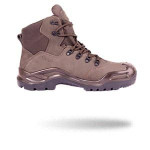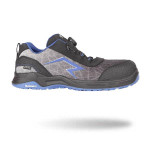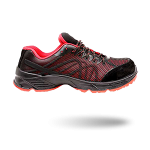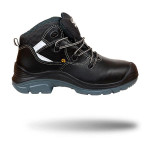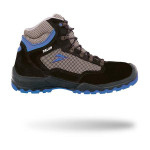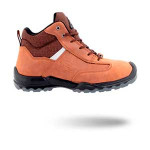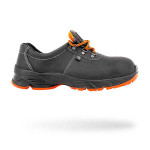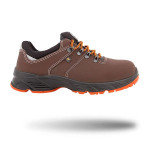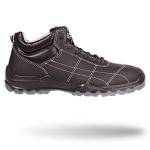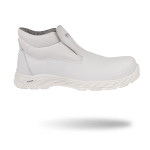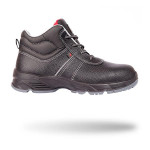Standards
PROTECTION CLASS |
REQUIREMENTS |
SB |
Basic requirements (see above) |
S1 |
As SB, plus Closed seat region Antistatic properties Energy absorption of seat region Resistance to fuel oil |
S1P |
As S1, plus: Penetration resistance |
S2 |
As S1, plus: Water penetration and absorption |
S3 |
As S2, plus: Penetration resistance Cleated outsole |
Please note that every protection class was developed for special conditions: for example, for job in e.g. logistics in a warehouse without any work to do outdoors the S1P class would be a perfect solution as it offers great breathability.
The same is valid for the slip resistance of the footwear. The SRC class is a versatile solution, but maybe SRA or SRB will be enough for you? For more information check the table below:
LABEL |
CHARACTERISTICS TESTED |
TEST CONDITIONS |
FRICTION COEFFICIENT |
|---|---|---|---|
SRA |
Slip resistance on ceramic tile floors with sodium lauryl sulfate solution (SLS) |
Forward
slip of the heel |
No
less than 0.28 |
SRB |
Slip resistance on steel floors with glycerol |
Forward
slip of the heel |
No
less than 0.13 |
SRC |
Slip resistance on ceramic tile floors with sodium lauryl sulfate solution and on steel floors with glycerol |
Includes
all test conditions cited under a. and b. |
|
There are additional protection features that the safety footwear can offer. For more information check the table below:
Additional requirements for special applications with corresponding symbols
SYMBOL |
RISK COVERED |
EN ISO 20345 |
EN ISO 20347 |
|||||||
|---|---|---|---|---|---|---|---|---|---|---|
SB |
S1 |
S2 |
S3 |
S5 |
OB |
O1 |
O2 |
O3 |
||
– |
Basic |
✓ |
✓ |
✓ |
✓ |
✓ |
✓ |
✓ |
✓ |
✓ |
P |
Penetration resistance* |
⍟ |
⍟ |
⍟ |
✓ |
✓ |
⍟ |
⍟ |
⍟ |
✓ |
A |
Antistatic footwear |
⍟ |
✓ |
✓ |
✓ |
✓ |
⍟ |
✓ |
✓ |
✓ |
E |
Energy absorption around heel |
⍟ |
✓ |
✓ |
✓ |
✓ |
⍟ |
✓ |
✓ |
✓ |
HI |
Heat insulation |
⍟ |
⍟ |
⍟ |
⍟ |
⍟ |
⍟ |
⍟ |
⍟ |
⍟ |
CI |
Cold insulation |
⍟ |
⍟ |
⍟ |
⍟ |
⍟ |
⍟ |
⍟ |
⍟ |
⍟ |
WRU |
Water resistance of upper |
⍟ |
✓ |
✓ |
⍟ |
✓ |
✓ |
|||
HRO |
Heat resistance of outsole (+300 °C/min) |
⍟ |
⍟ |
⍟ |
⍟ |
⍟ |
⍟ |
⍟ |
⍟ |
⍟ |
WR |
Whole shoe waterproof |
⍟ |
⍟ |
⍟ |
⍟ |
⍟ |
⍟ |
⍟ |
⍟ |
|
M |
Metatarsal protection |
⍟ |
⍟ |
⍟ |
⍟ |
⍟ |
⍟ |
⍟ |
⍟ |
⍟ |
FO |
Resistance to oil and petrol |
⍟ |
✓ |
✓ |
✓ |
✓ |
⍟ |
⍟ |
⍟ |
⍟ |
✓ =>
Meets the specific requirement
⍟ =>
Requirement can be met but is not stipulated

